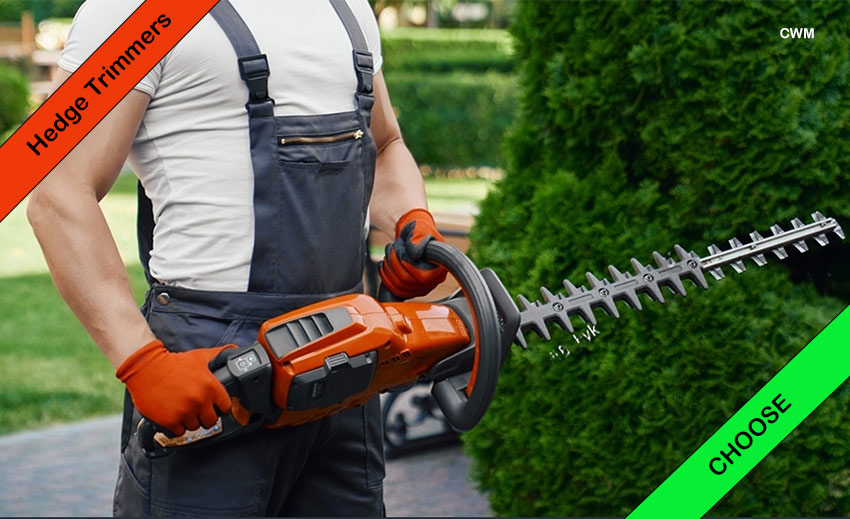Hedge trimmers are essential tools for maintaining a neat garden. Whether you’re looking to trim hedges, bushes, or shrubs, having the right hedge trimmer is crucial for getting the job done efficiently and effectively. With so many options available, it can be difficult to know where to start. In this article, we’ll discuss the key factors to consider when choosing a hedge trimmer, and provide a comprehensive guide to help you make an informed decision.
With so many hedge trimmer models to choose from, it may be difficult to know where to begin when investing in a hedge trimmer. That is why we have created this introduction to the wonderful world of hedge maintenance, providing a brief overview of some of the aspects to keep in mind
Table of Contents
Power Source
One of the first things to consider when choosing a hedge trimmer is the power source. There are three main options: electric, gas, and battery-powered. Electric hedge trimmers are ideal for smaller jobs and for use in residential settings. They are easy to start and require less maintenance than gas-powered hedge trimmers. Gas-powered hedge trimmers are ideal for larger jobs and commercial use. They offer more power and mobility than electric hedge trimmers, but they also require more maintenance. Battery-powered hedge trimmers are a good option for those who are looking for a portable, lightweight, and low-maintenance solution.
Corded, Battery-Powered, and Petrol Hedge Trimmers
Corded Electric Hedge Trimmers
Because they require access to a power source, corded hedge Trimmers are best suited for usage in smaller gardens. Nonetheless, these machines are often simple to operate, lightweight, and affordable, making them ideal for beginning users. Another reason corded hedge Trimmers are becoming more popular is the lack of exhaust emissions, excessive noise, and repair needs associated with gasoline machines.
Cable length is an important consideration here, so make sure your machine is appropriately suited for the size of your garden. You should also purchase a residual-current circuit breaker (RCCB) to prevent problems if you mistakenly cut the power cord.

Battery-powered hedge Trimmers
These provide the same clean, quiet, and simple operation as corded trimmers, but with the extra freedom to wander in bigger or more difficult landscapes. This makes them perfect for the bulk of household hedge care tasks, with contemporary lithium-ion batteries providing ample run time for continuous cutting and cutting performance that may sometimes rival that of a petrol machine.
However, before purchasing a machine, be sure to examine the average run duration, since there are few things more frustrating than having to stop and recharge your batteries with half of the garden still untrimmed!
Gas or Petrol Hedge Trimmers
Petrol hedge trimmers are often intended for bigger gardens and professional applications, owing to their great cutting power and total flexibility to function while not connected to a power source. This makes them ideal for usage on vast properties and on scrubland, which frequently has the most difficult cutting job.
However, gasoline hedge trimmers are heavier, louder, and emit more pollution than electric equipment. They also require more maintenance and can be more expensive to operate, and refueling can be a tricky procedure at times. As a result, these devices are not often advised for beginning users.
Blade Length
Another important factor to consider when choosing a hedge trimmer is the blade length. The blade length will determine the size of the branches you can trim and the size of the area you can cover. Hedge trimmers are typically available in blade lengths ranging from 18 inches to 40 inches. For small jobs, a blade length of 18 to 20 inches is ideal. For larger jobs or commercial use, a blade length of 30 to 40 inches is recommended.
Blade Type
Another point to remember is the distinction between single-sided and double-sided hedge trimmers. The type of blade is another important factor to consider when choosing a hedge trimmer. There are two main types of blades: dual-action blades and single-action blades. Dual-action blades have a cutting action that moves back and forth, which reduces vibration and makes the hedge trimmer easier to use. Single-action blades have a cutting action that moves in one direction, which makes them more efficient for cutting thick branches.
Tooth Gap: The phrase “tooth gap” refers to the spacing of the teeth on the blade of your hedge trimmer, which controls the greatest diameter of the plant you can cut. A tooth gap of 16mm-20mm will be enough for most regular trimming work, however machines with bigger tooth gaps are available for the hardest commercial cutting tasks.
Single-sided hedge Trimmers
These are specialized equipment that is often used to trim long, straight lines of hedgerows. This is because they may be equipped with a longer blade than a double-sided trimmer without the machine becoming unbalanced. Clipping collectors, which assist assure ease of cutting by eliminating loose vegetation as you work, may be included (or compatible with) single-sided hedge trimmers.
Double-Sided Hedge Trimmers
The majority of customers will perhaps prefer to buy a double-sided hedge trimmer, which has shorter blades for more maneuverability and allows you to easily change the direction of the cut. Because of their versatility, double-sided trimmers are appropriate for most household gardens and provide the simplicity of use when trimming shrubs and bushes.
Cutting Capacity
The cutting capacity is another important factor to consider when choosing a hedge trimmer. The cutting capacity is the thickness of the branches that the hedge trimmer can cut. Hedge trimmers typically have a cutting capacity ranging from 3/8 inch to 2 inches. For smaller jobs, a cutting capacity of 3/8 inch to 1 inch is ideal. For larger jobs or commercial use, a cutting capacity of 1 inch to 2 inches is recommended.
Weight
The weight of the hedge trimmer is also an important factor to consider. A heavy hedge trimmer can cause fatigue and make it difficult to use for an extended period. A lightweight hedge trimmer is easier to handle and maneuver, but may not have the power needed for heavy-duty jobs.
Features
Finally, consider the features that the hedge trimmer offers. Some hedge trimmers have adjustable blades, which allow you to adjust the angle of the blades for different cutting positions. Other hedge trimmers have rotating handles, which make it easier to reach and trim difficult-to-reach areas. Additionally, some hedge trimmers have an automatic oiling system, which helps to extend the life of the blades.
Choosing the Right Hedge Trimmer FAQ

How do I choose a hedge trimmer?
Choose a Blade Size
Blades of 16 inches or less are appropriate for small and medium-sized hedges.
18-inch blades are appropriate for medium to large hedges.
Hedge trimmers with 20-inch or bigger blades are appropriate for thick branches and large, established hedges.
What are the three types of hedge trimmers?
The 3 major types are corded electric hedge trimmers, cordless battery-powered hedge trimmers, and gas or petrol hedge trimmers, each of which will meet the demands of various users.
Which is better single or double-sided hedge trimmer?
As previously stated, double-sided hedge trimmers are by far the most popular kind available and are often the best choice for the overwhelming majority of hedge management tasks, ranging from basic trimming in home settings to precision shaping and topiary in formal and ornamental gardens.
What is the difference between a hedge trimmer and a hedge cutter?
What exactly is the difference between a hedge trimmer and a hedge cutter? Hedge trimmers are often used for ‘light work’ on branches and shrubs. Another of its tasks is to tidy up and shape bushes. Heavy-duty labor, such as cutting down large branches and thicker shrubs, is better suited to hedge cutters.
Is a battery or electric hedge trimmer better?
Gas-powered hedge trimmers are more powerful, making them ideal for larger operations. You also don’t need to worry about having extra batteries on hand if you’re working on a larger hedge-cutting operation.
Choosing the Right Hedge Trimmer, Final Thoughts
In conclusion, when choosing a hedge trimmer, consider the power source, blade length, blade type, cutting capacity, weight, and features. By taking the time to research and compare your options, you can find the best hedge trimmer for your needs and get the job done efficiently and effectively.
In many situations, they will only be relevant for specialized or commercial uses, but even inexperienced users can benefit from being acquainted with the language surrounding hedge trimmers, particularly if you have vast hedgerows to manage on your property.
Double vs. Single Cutting Action: Nowadays, most hedge trimmers employ a double cutting action, in which two blades work against one other to slice through difficult foliage. These machines are more popular because they cut more smoothly and with less vibration than single-action hedge trimmers, which have one moving and one fixed blade. It is critical not to confuse this with double-sided and single-sided machines (a single-action hedge trimmer will usually still have a double-sided blade).
Of course, if this introduction has inspired your interest in hedge maintenance, there is lots more to learn about hedge trimmers. Check out our other articles for more helpful advice and information
if you have any further questions please don’t hesitate to get in touch with our knowledgeable team, here at CWM. Leave any questions or comments in the comments section below.


I recently started tackling some yard work and was in need of a hedge trimmer. This guide on choosing the right one was exactly what I needed! The information provided was clear, easy to understand, and covered all the important factors to consider when making a purchase. I appreciated the tips on how to use a hedge trimmer safely and effectively. I feel much more confident in my decision to purchase a hedge trimmer thanks to this helpful guide. Thank you!
This was useful to me because I have a large garden. The advice on determining the size of the property is pretty helpful for someone like me. I like the emphasis on user comfort and the ability to handle larger jobs. Thanks